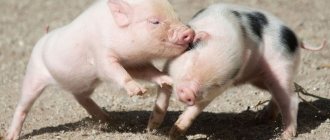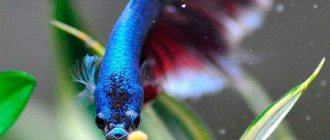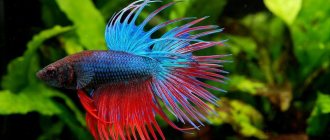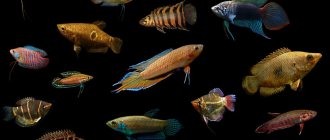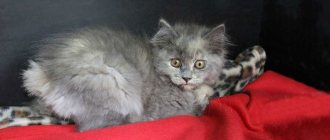Bettas are the most beautiful and diverse freshwater aquarium inhabitants. Despite the rather modest appearance of wild bettas, they have settled in domestic ponds around the world and have taken on impossibly beautiful breeding forms. The historical homeland of the betta fish is Thailand, where they live in stagnant waters or reservoirs with minimal current. All types betas have a labyrinthine organ that allows them to breathe atmospheric air. Therefore, the aquarium should be closed not with a lid, but with a net, so that the pet does not suffocate, but also does not jump out of the aqua house.
Description of the species
This fighting fish came to us from Southeast Asia, where it lives in large numbers in small streams and rice fields. Of course, the fish there are significantly inferior in appearance to the modern variations that appeared during a long and painstaking selection. But the homeland of this unsurpassed species of fish is there.
The cockerel belongs to the Labyrinth family, to the genus Betta. There are several dozen subspecies of them, which differ from each other both in appearance and in the degree of aggressiveness. In Latin, betta fish are called Betta splendens.
Cockerel fish in an aquarium
Males are brighter than females and larger; in an aquarium they will be its decoration. Females of this species have shorter fins and a faded coloration, although in recent decades fish have been bred in which the females are brightly colored. But against the background of males they will look inconspicuous.
The color of the fins can range from gray to deep blue, and their shape depends on the specific species. Thus, the veil-tailed betta is significantly larger in size than the shorter fin-shaped variations, and looks great in the aquarium. The average size of betta splendens is 5–6 cm, with females being slightly smaller.
Diseases
Cockerels like to be petted, but this should be done rarely and carefully so as not to disturb the protective layer, otherwise infection will occur. Don’t be scared when the fish lies on its side on the bottom - it’s normal, if not for long. The onset of the disease is judged by the appetite and behavior of the cockerels, so pets should not be overfed and care of the aquarium should not be taken seriously.
Fin rot
The color of infected fish first fades, then the fins become covered with ulcers, rot and disintegrate, causing death. The disease is treated with streptocide and salt baths.
Oodiniosis velvet disease
The body of the cockerels is covered with a light yellow coating, the scales break and split. The color turns pale, the fish's fins droop, and it is difficult for it to breathe. Treat with antibacterial agents after disinfection and maintaining an elevated temperature in the aquarium.
Gill flukes
The causative agent is a fungus that grows to large sizes so that it hangs from under the gill covers. The disease is indicated by the appearance of mucus, a swollen body and discoloration, loss of appetite and difficulty breathing.
Ichthyophthiriasis semolina
The sick cockerel, the photo of which is presented above, is covered with small white dots, similar to semolina. Then he loses appetite and weight, becomes lethargic, breathes slowly, and swimming resembles twitching. Salt baths for 2-4 weeks will help cure the disease.
Dropsy
The abdomen is swollen and the eyes are swollen, the scales are raised, there are red spots on the stomach and near the fins, there is no appetite, lethargy. Treated with disinfection of equipment, Bicillin streptocide, weak manganese solution.
Columnaria
The cause of “mouth fungus” is bacteria. Symptoms: a swollen body close to the gills, which are covered with a dark coating, the mouth is affected, the eyes are filled with cloudy fluid. Treat with systemic complex antibiotics.
Costiosis
Appears as gray spots, the skin becomes cloudy, and there is copious mucus discharge. The disease is transmitted by the flagellate parasite. After starting treatment, recovery occurs within 7 days.
Bug-eye exophthalmia
The causative agent is a virus. The cockerel's eyes become enlarged, become cloudy and covered with a white coating. In advanced cases, the fish goes blind and dies. Sometimes it is enough to pour clean water and reduce the diet. In difficult cases, they are treated with ointments and antibiotics.
Conditions of detention
Caring for a Siamese betta fish is simple and even a novice aquarist can handle it. The water temperature should be 24–27 degrees, ph should be 6.0–8.0, and its hardness should be within the range of 5–35 dGH. But in practice, deviations from these indicators are possible; the betta fish will easily tolerate this without harm to itself.
Keeping and caring for a fish seems all the more uncomplicated when you find out that keeping betta fish is possible in a simple three-liter jar. Betta splendens have a special respiratory organ that gives them the ability to inhale atmospheric air. All labyrinth fish have it, and it is because of it that this family got its name.
Origin
Southeast Asia is considered the birthplace of the betta fish. Its main habitats are warm, fresh, slow-flowing or stagnant bodies of water in Thailand, Vietnam, the Malay Peninsula and the islands of Indonesia.
The first mention of this unusual fish occurs in history in 1800. At that time, the inhabitants of Siam (now Thailand) noticed the increased aggressiveness of the males of this fish towards each other and began breeding a special breed for fights with monetary stakes.
Cockerels were introduced to Europe in 1892. The first countries to see the miracle fish were France and Germany. They came to the USA in 1910, where Frank Locke developed a new color version of the cockerels. In Russia, the history of their appearance is associated with the names of V.M. Desnitsky and V.S. Melnikov and date back to 1896.
Nutritional Features
Betta fish require a balanced diet, which is easy to provide at home. It should be based on frozen food (bloodworms, brine shrimp, daphnia) and specialized mixtures sold in pet stores. Do not overfeed your pets, otherwise the water will quickly spoil. In addition, overfeeding can lead to obesity, and as a result, a reduction in life expectancy. A male cockerel may also lose the ability to reproduce.
Betta cockerels happily eat live food, but you need to be extremely careful here. After all, pathogenic microorganisms can also enter the aquarium along with them, as a result of which the betta fish can get sick and die. In a separate article we look at popular diseases of betta fish.
The filtration system will help remove fish waste, as well as food residues. With its help, caring for your betta fish will be really simple. The main thing is not to forget to clean the filter on time so that the accumulated pieces of debris in it do not fall back into the water.
Well, the last thing worth adding about feeding: food for a betta should not be too large, the fish should swallow it easily.
Compatibility of betta fish
Bettas are lively and cocky pets who find it difficult to get along even with their own kind. The male will never be able to calmly endure the existence of another - constant fights will begin. However, this does not mean that these fighting fish have to live alone. Other residents of the spacious aquarium will help recreate the animal’s natural habitat and improve its well-being.
It is very important to choose the right neighbors with whom the betta fish can easily get along. Species whose representatives are quite peaceful and do not have large (more than 5 cm) body sizes are well compatible with bettas. These include guppies, swordtails, neons, gouramis, cardinals and speckled catfish.
You should not add fin-picking fish, such as dwarf tetradons, to your bettas. However, bettas themselves are not against biting off the “clothing” of their beauty competitors. Aquarium bettas sometimes mistake veiled fish of other species for representatives of their own, so they rush to attack.
Also, you should not keep cockerels with large predators. Cichlids, Astronotus, Polypterus - all of them often mistake small fish for food, and a small cockerel with its large fins will become the subject of aggression in the first place.
It is best to place fish in an aquarium from a young age. In this case, they will be able to get used to each other, and there will be much less fights and skirmishes. If a betta fish's neighbor dies, you should not introduce another fish in the near future - the betta may kill it.
You can share two or three females with one male aquarium betta to make him feel calmer. Make sure their home has enough space for betta girls to hide.
The fish will feel comfortable in a spacious tank (volume more than 50 liters). If there are a lot of decorations and plants in the aquarium, then territorial disputes between its inhabitants will not arise.
Reproduction
Reproduction of betta fish is not difficult and can be achieved even by inexperienced aquarists. The main thing is to choose the right pair of producers, then successful spawning is guaranteed.
The hen (as the females of this species are called) must be ready to reproduce; her readiness is indicated by the white eggs in the anal fin area. A male is selected that is not too young, but not too old, at least 8 months old.
Caring for fish before breeding is important; it is typical for all labyrinths. Selected breeders are kept separately from each other (2 weeks), generously fed with bloodworms and other food. Then they are transplanted into a spawning aquarium with a volume of 15–20 liters, on the surface of which there should be riccia. From it and air bubbles, the male builds a nest, where eggs are subsequently deposited. The spawning process is very interesting and everyone should watch it. After spawning, the female must be removed, otherwise the cockerel may kill her.
Interesting Facts
- In South Asia, cockerels were used for fighting with money stakes. Fights, as a rule, did not lead to the death of fish; it ended with frayed tails. Now such fights are prohibited.
- A male cockerel can fight until he is completely exhausted even with his reflection in the mirror.
- These fish are endowed with two respiratory systems: gills and a labyrinth organ.
- Cockerels show sympathy for the opposite sex in a very interesting way: the female “fidgets” back and forth, and the male protrudes his gills and fins and wriggles his whole body.
Some tips
A cockerel that was not kept properly before spawning, that is, it was not fed enough, can eat caviar. The same behavior is observed in young fish that were first placed for spawning. In the future, this goes away in most individuals.
Cockerel fish
When buying fish, you should not choose the largest and brightest individuals, this indicates their age. The larger the cockerel, the older it is, which means it will live less and may not produce healthy offspring.
Aeration should not be turned on in the spawning tank; it can ruin the entire breeding process. The male himself makes bubbles for the nest from the air, and actively purging the water with oxygen will only disturb him.
In an aquarium containing fish with veil fins, there should be no objects with sharp edges that could damage their long fins. Therefore, it is better to refrain from decorating the bottom with different castles and grottoes.
This species is one of the most successful in terms of selection; many colors and fish with different fins have been bred. The table of contents of books on the selection of aquarium species necessarily includes the genus Betta.
Preparing a mini-aquarium and populating it
Experienced aquarists recommend choosing only spacious aquariums for betta fish; 1 individual should have at least 5 liters of water. The recommended optimal tank volume is from 10 liters. The main criteria for arranging a mini-aquarium:
- The correct choice of aquarium shape is important. It is often practiced to keep a betta in a round aquarium; sometimes jars, glasses or glasses are used. In the last three options, the pet has nowhere to turn around and may die. The round shape of the container is inconvenient to handle; such an aquarium cannot be cleaned with a scraper. Some sources indicate that keeping them in a round bowl is harmful to your pet’s vision and health. It is better to keep your pet in a rectangular container.
- The fish’s home cannot be tightly closed with a lid, since it must remain possible to rise to the surface of the water and breathe. To prevent your pet from jumping out, it is better to use a soft mesh.
- There is no need for aeration and filtration systems due to the peculiarities of the respiratory system of cockerels. The only accessories you should purchase are a small water heater.
- A small amount of soil should be placed at the bottom. For this, any type of gravel, stones, glass beads, balls are used. Items must be free of chemical residues.
- After arranging the soil, plants and small decorations are placed so that they do not interfere with the movement of the fish in the water space. It is better to use artificial plants in a small aquarium, but they should not injure the betta's fins with sharp edges. Live aquarium plants look more beautiful, but in small spaces they quickly spoil the water under the influence of heat, sunlight and other factors. It is best to choose plants made from silk.
- Filtered drinking water is poured into the tank. Distilled water is not suitable because it lacks the minerals your pet needs. Tap water should be dechlorinated first.
- Before introducing your pet into the prepared aquarium, you need to leave it for 24 hours.
- It is recommended to place the aquarium in a quiet place where it is not hot and there is moderate lighting. Intense sunlight will provoke the growth of green algae, the proximity of heating devices will affect the water temperature, and the noise will cause stress to the betta, and fin rot may begin.
A pet bought in a store is placed in a container next to a furnished home so that the water in the containers becomes the same temperature. After this, the container with the fish is lowered into the tank so that the fish can move on its own. You can transfer the fish using a net.
Raising fry
After 1-2 days the fry begin to hatch. Until they completely “eat” their yolk sac, there is no need to feed them.
With the appearance of the first babies, the male must be removed to avoid being eaten. The amount of water is reduced by another 5-7 cm, aeration is set to maximum. This is necessary for the entire period of formation of the labyrinthine mechanism in the offspring - 1-1.5 months.
Then the young males can already breathe atmospheric air, so the water level is gradually increased, and its oxygen saturation is reduced using aeration.
Feeding begins with live, but thoroughly washed food - bloodworms, ciliates, Artemia nauplii. You can gradually add boiled egg yolk to your diet.
The growth rates of fry are different. Larger individuals must be gradually removed to prevent cannibalism.
